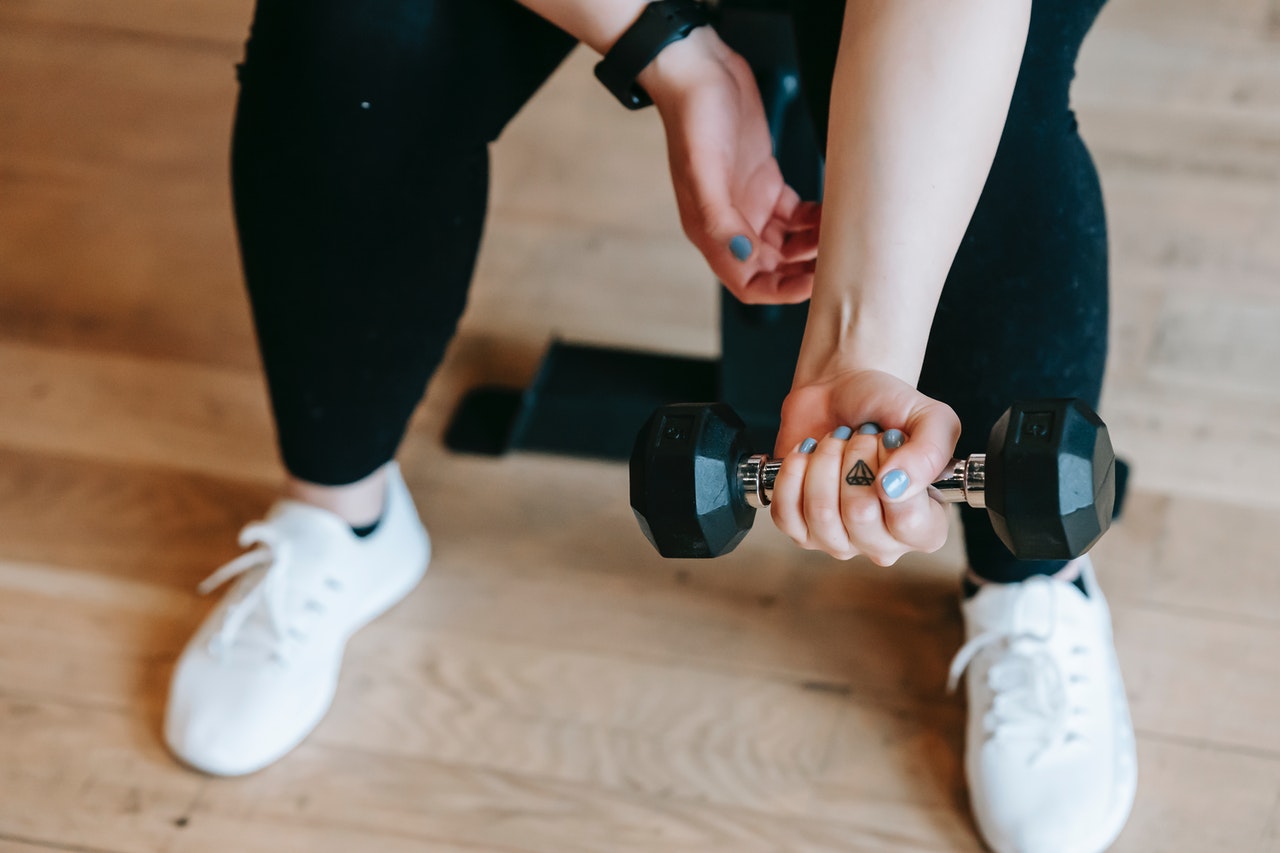Weightlifting, powerlifting, bodybuilding, or the more widely known term “weight training” all involve the use of weights as a form of exercise (or even competition!). While popular since the beginning of time, with rocks aimed to be lifted in order to show off one’s physical ability in places like Ancient Greece, it has been mostly male-dominated and surrounded by false myths that have perpetuated a distance between women and this popular form of exercise.
The most common assumptions around weight training relate to ideas of women becoming too muscular and bulky within a short period of training. Not that there is anything wrong with women having or aspiring to have a more muscular figure, but this idea is simply a myth! Including weights – yes, even heavy weights – in your workout routine is not going to magically lead to the muscular figure many have in mind when hearing the word “weights.” Of course, weight training can be used for adding muscle volume, however, it will not simply happen by lifting 100 kg; it is a rather complex process where diet, workout plans and time management have to align well to achieve a certain result.
Before I get into the benefits of including weight training in your workout routine, it is important to acknowledge that a lot of women want to gain muscle mass across their body but are deterred by comments made by strangers, coworkers or even family members. Here at Her Nexx Chapter, we want women to feel empowered and have agency of their bodies. Inevitably, women who lift will be exposed to a few unnecessary comments, but it is important to not let others put you off from achieving your goals. These are our bodies, and we can do whatever we want!
So, let’s get into it! What are some of the benefits of weight training?
1) Reduced heart disease issues: Weight training lowers blood pressure by increasing good cholesterol.
2) Increased bone density: Combined with the strengthening of the muscles, there is a lower risk of fractured bones. The strengthening of the connective tissue also helps prevent injury by increasing joint stability.
3) You burn more fat: After weight training your metabolism remains elevated for up to 48 hours, unlike cardiovascular exercise where your metabolism slows down soon after the exercise is done. This means that you continue to burn fat for longer, making it an effective tool for weight/fat loss.
As this is a guide, I will focus on 5 aspects of weight training that are necessary to know before heading to the gym:
What should I wear?
While there is no particular dress code for the gym and the most important thing is to feel comfortable in your own clothes, it is encouraged to wear slightly tight-fitted clothing. This is because having the right form is necessary when performing exercises, especially if they are compound exercises such as deadlifts and squats. Wearing tighter clothes will allow for better visuals when looking at yourself in the mirror (yes, take advantage of the gym mirrors; they are there for a reason!), allowing for corrections in form.
You should also avoid regular sneakers and running trainers or gym shoes. Weight training requires a flat surface for better balance and posture during the workouts. Shoes like Vans and Converse are perfectly acceptable. Specialised weightlifting shoes can also be used, as they have a slightly raised heel which aids with stability and mobility when doing free weight exercises – meaning without the use of machines. However, they tend to be on the pricey side, so regular flat shoes or even no shoes at all work perfectly fine!
Is there anything I need to know before and after my workout?
Yes!
Warm-up, activation and stretching exercises are a vital part of your workout routine, especially in weight training. Before workouts, our muscles and joints are stiff and do not have the appropriate blood flow to aid with oxygen and glucose delivery. These are important to prevent injury and prepare our muscles for more intense physical exercise, thus increasing our athletic performance.
Appropriate warm-up exercises for lower body workouts include body weight squats, donkey kicks, sideways leg kickbacks and straight leg kickbacks. You can add a 5-to-10-minute cardio to these warmup exercises, such as the Stairmaster or the bike. Warming up the ankle, knees and hip joints will prevent injury and increase mobility in the lower body.
Appropriate warm-up exercises for upper body workouts include arm circles, lateral raises and shoulder presses (do these with a very light weight!). The shoulder is a highly mobile joint, thus it can easily become injured if not thoroughly warmed up.
What are activation exercises? Many women who attempt glutes-focused workouts report that they do not feel the exercises in this area but rather on their quads and hamstrings. While this could be due to a couple of reasons, a main one is that they have not activated their glutes prior to the main workout. Many of us work from our desks, meaning that we rarely use our glute muscles outside the gym. This tightens the muscles and makes it difficult to ‘’wake them up.’’ Try doing some activation exercises after your warm-up, such as fire hydrants, hip thrusts with no weight and single-leg abductions and it is guaranteed you will feel the burn!
Finally, stretching! I learned this the hard way, as I avoided stretching after my workouts with the excuse that I was too tired. After months of weightlifting and not stretching, my muscles became stiff, and my mobility wasn’t great. As I was getting a professional massage, the masseuse was shocked at how tight my muscles were and advised me to take up stretching classes to learn how to stretch effectively…and so I did!
Stretching not only speeds up recovery after each workout, but it helps keep the muscles elongated and flexible. This allows for more mobility and inevitably better performance during workouts. So, as much as you want to go home after a hard workout, it is better to skip an exercise from your workout plan than leave out your stretching routine. Foam rolling is also a great addition to stretching exercises, as it helps target muscular tightness.
What is the difference between main and accessory exercises?
Main exercises, also known as compound exercises, use a lot of muscle groups simultaneously. For example, deadlifts use most of your body, including the hamstrings, glutes, triceps, back and so on.
Accessory exercises, also known as isolation exercises, are used to target a particular muscle group. For example, the hip abductor machine helps you target the abductor muscles, which are found on your outer thighs, as well as the glutes.
Generally, it is advised to always begin your workout routine with compound exercises and end it with accessory ones. For example, you could do 3 compound exercises and end with 2 isolation ones to help tire out the muscles even more.
How should my workouts be planned?
There are 5 things you need to take into consideration when planning your workouts: sets, reps, rest days, progressive overload, and Delayed Onset Muscle Soreness (DOMS).
Sets are the groups of repetitions you need to do for an exercise. Likewise, reps are the number of times you need to perform an exercise for each set. For example, 3 sets of 10 reps means that you need to repeat an exercise 3 times, each time involving 10 repetitions. The sets are distinguished by a short break in between. These breaks should be around 30 seconds and no more than 60!
In compound exercises, it is advised to have a low number of reps, as the aim should be to gradually lift more weight. Imagine if every week you add 5 kg to your squats; it will be super difficult to do 20 reps with a new weight load! On the other hand, you can increase your reps for accessory exercises, as the aim is to tire out the muscle completely by the end of the day’s workout routine.
Unlike many workout influencers portrayed on social media, you don’t need to constantly be at the gym for long hours per day. You need recovery time for your muscles to grow and to help avoid injury. Do not feel guilty about that!
Progressive overload refers to the increase of weight that you use weekly, which is the key to muscle growth. This should be done gradually, as you don’t want to put extreme strain on your muscles and joints. As long as you are pushing yourself every time you go to the gym, you will be able to achieve your goals.
DOMS refers to the pain that you feel after a day or a few days of completing a workout. This pain is nothing to worry about (unless it is spinal pain), and it shows that you worked hard and put your muscles through discomfort, which is necessary for muscle growth. Fortunately, you can still work out with DOMS – it actually helps relieve the pain! However, having DOMS isn’t the only sign that your workouts are effective. You don’t need to be in pain to be reassured; like mentioned above, as long as you are pushing yourself as much as you can, you will be fine!
While this is not a guide to nutrition, it is important to note that whether you lose, maintain, or gain weight highly depends on your diet. Being on a calorific deficit means that you are consuming less calories than your body needs, and you are thus going to lose weight. On the other hand, being on a calorific surplus means that you are eating more calories than your body needs and will start gaining weight. Sometimes, we put a lot of focus on working out when, in reality, diet is a bigger influence on weight gain or weight loss.
Finally, it is important to note that I am not a medical specialist, just someone who has been weight training for a long time, so if you seriously injure yourself, please seek professional help.
Now that you are aware of the basic steps to beginning weight training, start planning your workout and put these rules into practice!
Her Nexx Chapter invites you to join our free Community where women from around the world are connecting with each other’s stories, exploring different experiences, and transforming ideas.
The Future of Connection for Women
- Promoting Healthier Eating and Sustainable Foods This National Nutrition Month - March 30, 2023
- Holiday Gift Ideas for That Special Someone in Your Life - December 20, 2022
- Know Your EQ? A Guide to Understanding Emotional Intelligence - December 6, 2022
Follow us:







